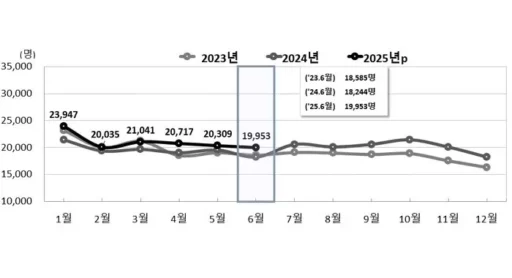Birth Rate Increases for 12 Consecutive Months, Record Growth Rate in June
In June, the number of newborns reached 19,953, marking a 9.4% increase compared to the same month last year. This represents the highest growth rate for June since statistics began being recorded in 1981.
Highest Growth Rate
The number of newborns has been increasing for 12 consecutive months, primarily due to a rise in marriages among those in their early 30s, known as the 'Echo Boom Generation' (born 1991–1996), who are now of marriageable age.
According to the Population Census released on the 27th, the total fertility rate (the average number of children one woman is expected to have in her lifetime) for June was 0.76, an increase of 0.06 from the previous year.

However, the monthly number of newborns, which had been maintained at around 20,000 since the beginning of this year, did not hold steady this month.
A spokesperson from the Statistics Korea explained, "The increase in women in their 30s and changes in positive perceptions towards childbirth have impacted the rise in the number of newborns," adding that increases were observed in all provinces except Jeju.
Highest Ever Birth Rate Growth in the First Half and Second Quarter
In the first half of this year (January to June), the number of newborns was 126,001, which is an increase of 8,721 (7.4%) from last year (117,280).
For the second quarter, the number of newborns was 60,979, representing an increase of 4,157 (7.3%) compared to the previous year (56,822), marking five consecutive quarters of growth.

The birth rate in both the second quarter and the first half reached historical highs, resulting in a total fertility rate of 0.76 for the second quarter, an increase of 0.05 from the previous year.
Looking at the birth rates by mother's age, those aged 25-29 increased by 0.5, 30-34 by 2.7, and 35-39 by 5.1, respectively.
In the second quarter, the proportion of first-born children among newborns increased by 1.3 percentage points, while the shares of second-born children and those born as third or later decreased by 0.8 percentage points and 0.4 percentage points, respectively.

The average duration of marriage for parents was 3.59 years, a decrease of 0.04 years from the previous year, while the average duration of marriage at the time of the first child's birth decreased by 0.01 years to 2.45 years.
Birth Rates by Province and Population Decline
In the second quarter, the total fertility rate by province was highest in Jeollanam-do at 1.04, followed by Sejong (0.99), Chungbuk (0.93), and Gyeongbuk (0.91). Compared to last year, all provinces except Jeju experienced an increase in the total fertility rate.
In June, the number of deaths was 27,270, an increase of 392 (1.5%) from last year, while the number of deaths in the second quarter was 84,565, which is 609 more (0.7%) than the same period last year.
When the number of deaths is subtracted from the number of newborns in June, there was a natural decline in population of 7,317, and the natural decline in the second quarter was 23,586, observed in 15 provinces excluding Sejong and Gyeonggi.

Marriages Increase for 15 Consecutive Months, While Divorces Decrease
In June, the number of marriages was 18,487, an increase of 1,539 (9.1%) compared to last year (16,948).
In the first half of this year, the number of marriages reached 110,065, which is an increase of 8,370 (8.2%) compared to the previous year, marking 15 consecutive months of increases since April last year.
For the second quarter, the number of marriages was 55,910, showing a 3,263 increase (5.8%) compared to the same period last year, marking six consecutive quarters of growth.
The general marriage rate (marriages per 1,000 people aged 15 or older) for the second quarter was 10.5 for men and 10.3 for women, both rising by 0.5 from the same period last year.

By type of marriage, first marriages for men increased by 3,797 (7.9%) compared to last year, while remarriages decreased by 550 (7.3%). For women, first marriages also increased by 3,750 (7.9%), but remarriages fell by 507 (6.2%).
In June, the number of divorces was 6,777, a decrease of 429 (6.0%) from last year. In the second quarter, the number of divorces was 21,489, which is a decrease of 1,341 (5.9%) compared to the same period last year.
A representative from Statistics Korea concluded, "The increase in the population of those in their early 30s, changes in perceptions toward marriage, and the effects of policies such as marriage incentives have contributed to the increase in marriages."
Image source: Monthly trends in newborns nationwide / Statistics Korea, reference material for understanding the article / gettyimagesbank


